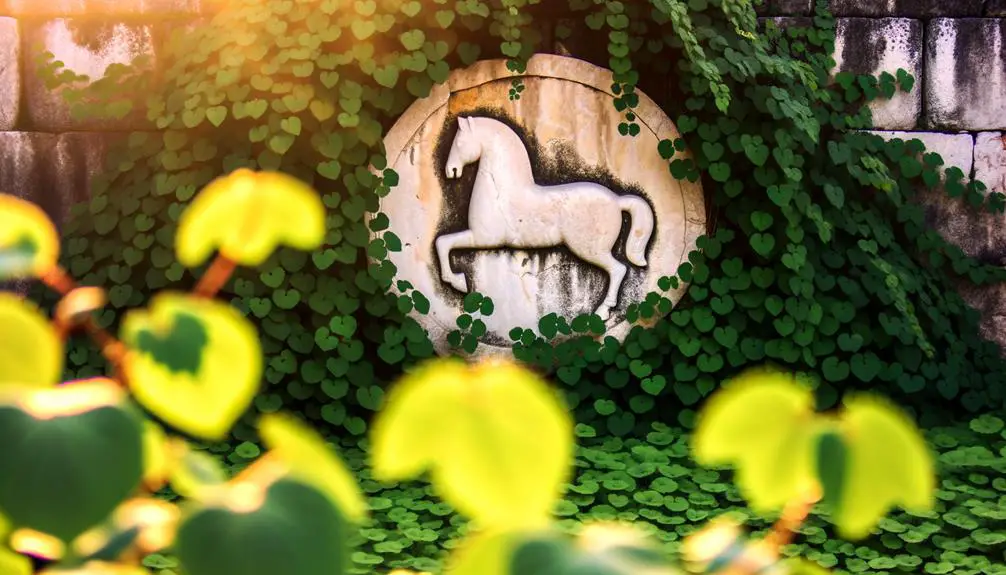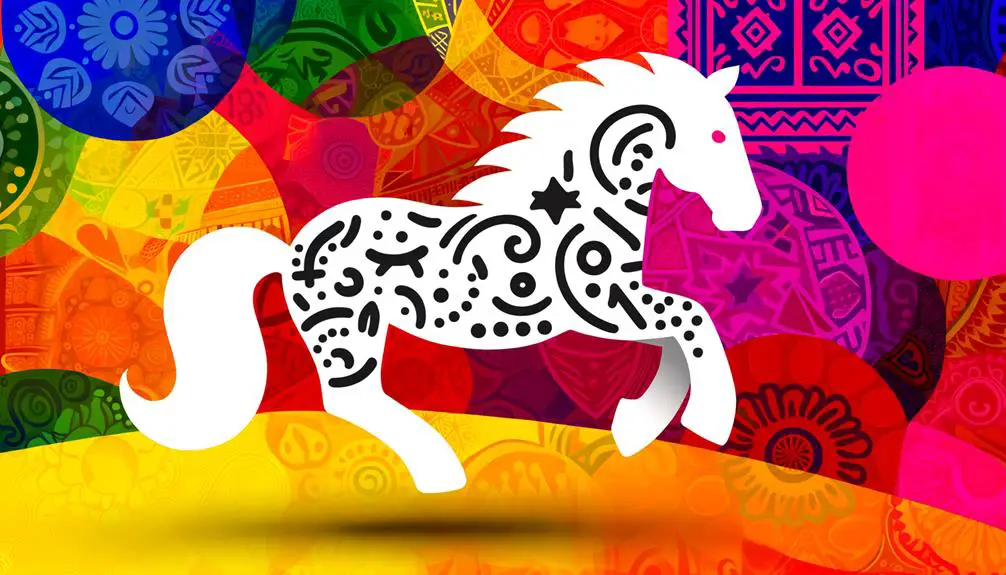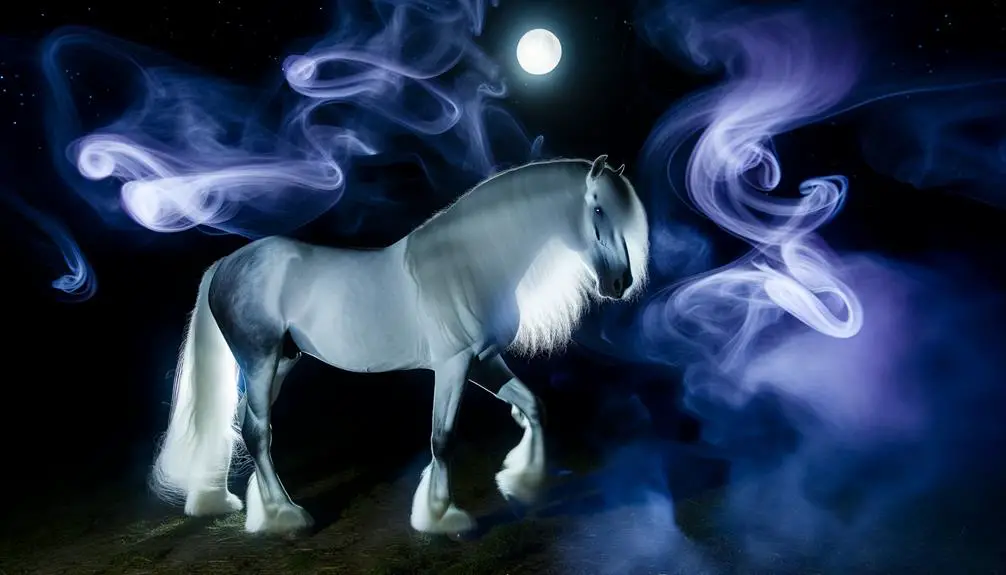What Does the Symbol of a White Horse Represent in Cultures?
The symbol of a white horse holds profound significance in various cultures and mythologies. Historically, it is associated with gods in ancient Greece and Rome, and symbolizes chivalry and heroism in medieval Europe.
In many cultures, the white horse represents purity, power, and spiritual transcendence, often linked to sacred rituals and divine favor. Literary texts like 'The Iliad' and 'Beowulf' depict white horses as emblems of nobility and heroism.
Additionally, its imagery pervades contemporary art, literature, and fashion, conveying notions of freedom, elegance, and transformation. This rich symbolism continues to shape cultural narratives and societal values across the globe.
Learn more about the multifaceted impact of this enduring symbol.

Key Takeaways
- The white horse symbolizes purity, power, and spiritual transcendence across various ancient cultures.
- In medieval Europe, white horses represent chivalry, heroism, and nobility.
- Literary works like 'The Iliad' depict white horses as noble and heroic figures.
- In Asian cultures, the white horse symbolizes good fortune and progress.
- White horses are used in contemporary fashion and design to evoke elegance and freedom.
Historical Significance

Throughout history, the symbol of the white horse has held significant cultural, religious, and mythological importance in various societies around the world. Its historical significance is multifaceted, often representing purity, power, and a connection to the divine.
In ancient civilizations, such as those of Greece and Rome, white horses were associated with the gods and were depicted in art and literature as majestic and noble creatures. In medieval Europe, they were seen as symbols of chivalry and heroism, frequently featured in tales of knights and their quests.
Additionally, white horses have been integral in royal ceremonies, symbolizing sovereignty and prestige. This enduring symbolism underscores the white horse's prominent role in shaping cultural narratives and societal values through the ages.
Mythological Roots
The mythological roots of the white horse symbol are deeply embedded in various ancient cultures, often representing purity and power.
Epic literary references, such as those in Greek and Norse mythology, frequently highlight the white horse as a noble and heroic figure.
Additionally, religious symbolism across different traditions underscores its association with divine intervention and spiritual journeys.
Ancient Cultural Significance
In ancient cultures, the white horse frequently emerged as a potent symbol in mythology, representing purity, power, and spiritual transcendence. This symbolism is evident across various civilizations, underscoring its universal significance.
The white horse was often associated with sacred rituals. It was used in ceremonies to invoke divine favor or symbolize purity.
Moreover, the white horse represented royalty and leadership. It signified authority and nobility, often depicted in royal processions.
Additionally, the white horse symbolized war and conquest, representing invincibility and valor on the battlefield.
Furthermore, the white horse was linked to mythological beings, enhancing their divine or heroic status.
Such representations reflect the white horse's multifaceted role in ancient societies, demonstrating its powerful imagery and the deep cultural meanings ascribed to it.
Epic Literary References
Building upon its ancient cultural significance, the white horse's symbolism also permeates epic literary texts, where it often serves as a powerful motif linked to mythological narratives and heroic tales.
In works such as 'The Iliad' and 'Beowulf,' white horses are depicted as noble steeds, embodying purity, strength, and divine favor. These animals often accompany heroes on their quests, symbolizing their elevated status and righteous mission.
Additionally, in Arthurian legends, white horses are frequently associated with knights and chivalric ideals, reinforcing themes of honor and valor. These literary references not only highlight the white horse's esteemed status but also underscore its role as a symbol of transcendence and otherworldly power within epic storytelling traditions.
Religious Symbolism
How does the white horse emerge as a potent symbol within various religious traditions, drawing from deep mythological roots that span across different cultures? This symbol often signifies purity, divinity, and power, appearing in numerous sacred texts and mythologies.
In Hinduism, the white horse is associated with Kalki, the final avatar of Vishnu, who is prophesied to bring an era of righteousness.
In Christianity, the Book of Revelation describes a white horse whose rider symbolizes conquest and ultimate victory.
Islamic eschatology features Al-Buraq, a heavenly steed that carried the Prophet Muhammad.
Additionally, ancient Greek mythology celebrates Pegasus, a divine white-winged horse linked to heroism and inspiration.
Cultural Interpretations

Across various cultures, the white horse often emerges as a powerful symbol imbued with diverse meanings and significance. In Western mythology, it is frequently associated with nobility, purity, and heroism, as exemplified by the legendary figure of Pegasus.
In contrast, Asian cultures, particularly in China, view the white horse as a harbinger of good fortune and a symbol of progress. Indigenous cultures in North America, such as the Lakota, interpret the white horse as a messenger of spiritual enlightenment and transformation.
Additionally, in European folklore, the white horse often heralds change or serves as a guide to the otherworld. These varied interpretations underline the white horse's universal resonance as a multifaceted symbol across human societies.
Religious Symbolism
In religious contexts, the white horse frequently symbolizes divine intervention, purity, and spiritual authority, often depicted in sacred texts and iconography. This powerful symbol appears across various religious traditions, each attributing unique yet overlapping meanings to its presence.
For instance, in Christianity, the white horse is prominently featured in the Book of Revelation, representing conquest and righteousness. Hindu mythology associates the white horse with Kalki, the final avatar of Vishnu, signifying the end of the current age of darkness.
- Divine Intervention: Representing a higher power's involvement in worldly affairs.
- Purity: Embodying innocence and moral integrity.
- Spiritual Authority: Denoting leadership endowed with divine approval.
- Apocalyptic Vision: Foretelling significant spiritual or cosmic transformations.
This multiplicity of meanings underscores the white horse's profound spiritual resonance.
Literary Appearances

The image of a white horse has been a recurring motif in literature, often symbolizing themes of heroism, purity, and transcendence.
In classical literature, the white horse appears in Homer's 'The Iliad,' notably as the steeds of the gods, underscoring divine intervention.
In medieval texts, such as those recounting the Arthurian legends, the white horse is often ridden by noble knights, representing chivalry and valor.
In modern literature, Cormac McCarthy's 'All the Pretty Horses' employs the white horse to signify the protagonist's quest for freedom and idealism.
Each instance of the white horse serves a symbolic function, contributing to a deeper understanding of character motivations and thematic underpinnings, thereby enriching the narrative's overall impact.
Contemporary Influence
The symbol of a white horse continues to exert a significant impact across various contemporary domains.
In modern media representation, it often embodies purity, heroism, and mysticism.
In fashion and design, it frequently appears as an emblem of elegance and timelessness.
Its recurring presence in contemporary art and literature underscores its enduring cultural resonance and multifaceted symbolism.
Modern Media Representation
Modern media frequently employs the symbol of a white horse to convey themes of purity, heroism, and transcendence. This symbol is utilized across various platforms, including films, television, and literature, to evoke powerful emotional responses and underscore narrative arcs. The white horse's representation often aligns with characters or situations embodying moral integrity and noble pursuits, effectively resonating with contemporary audiences.
Key aspects of its portrayal include:
- Heroic Journeys: Protagonists often ride white horses during pivotal moments.
- Fantasy Elements: White horses appear in otherworldly or magical settings.
- Symbolic Imagery: They serve as visual metaphors for triumph over adversity.
- Cultural Resonance: Their presence taps into historical and mythological connotations.
These elements collectively enhance storytelling by integrating rich, symbolic depth.
Fashion and Design
Extending beyond media, the symbol of the white horse has greatly permeated contemporary fashion and design, influencing aesthetic choices and brand imagery. This emblematic figure often evokes notions of purity, freedom, and elegance, making it a popular motif in high-end clothing lines and accessories.
Designers integrate the white horse into patterns, logos, and marketing campaigns to convey a sense of timeless sophistication. Moreover, the symbol's versatility allows it to be adapted across various styles, from minimalist to avant-garde. Its consistent presence in fashion underscores a broader cultural fascination and a desire among consumers for items that symbolize noble ideals.
Consequently, the white horse remains a powerful and enduring element in the visual language of modern design.
Art and Literature
In contemporary art and literature, the symbol of the white horse serves as a potent metaphor, often employed to explore themes of purity, freedom, and transcendence. This symbolism is instantiated across various mediums and genres, reflecting diverse interpretations.
- Visual Arts: Artists frequently depict white horses to evoke a sense of ethereal beauty and unattainable ideals.
- Literature: Writers use the white horse to symbolize characters' quests for moral or spiritual enlightenment.
- Film and Media: Cinematic representations often utilize white horses to signify pivotal moments of transformation or escape.
- Music: Songwriters incorporate the white horse as a lyrical device to convey messages of liberation and hope.
This emblematic creature therefore remains a versatile and enduring motif, resonating with contemporary audiences.
Conclusion
The white horse, a timeless emblem, gallops through the annals of history, myth, and culture, embodying purity, power, and transcendence. Its presence traverses religious texts, literary works, and modern narratives, weaving a tapestry of profound symbolism.
Analyzing its multifaceted representations reveals the enduring allure and complexity of this majestic creature. The white horse stands as a beacon of hope and an icon of transformation, its significance perpetually evolving yet steadfast in its cultural resonance.






